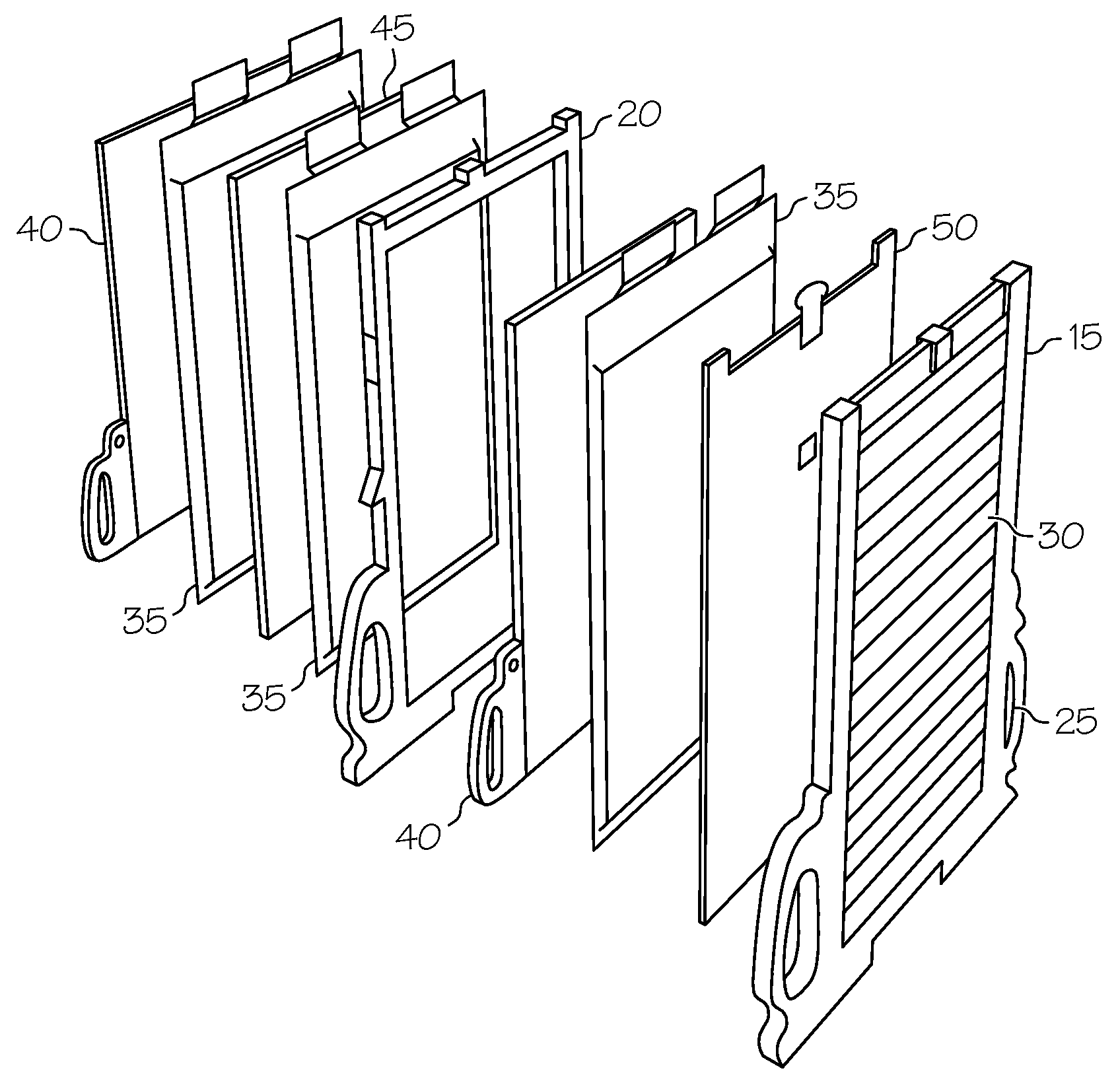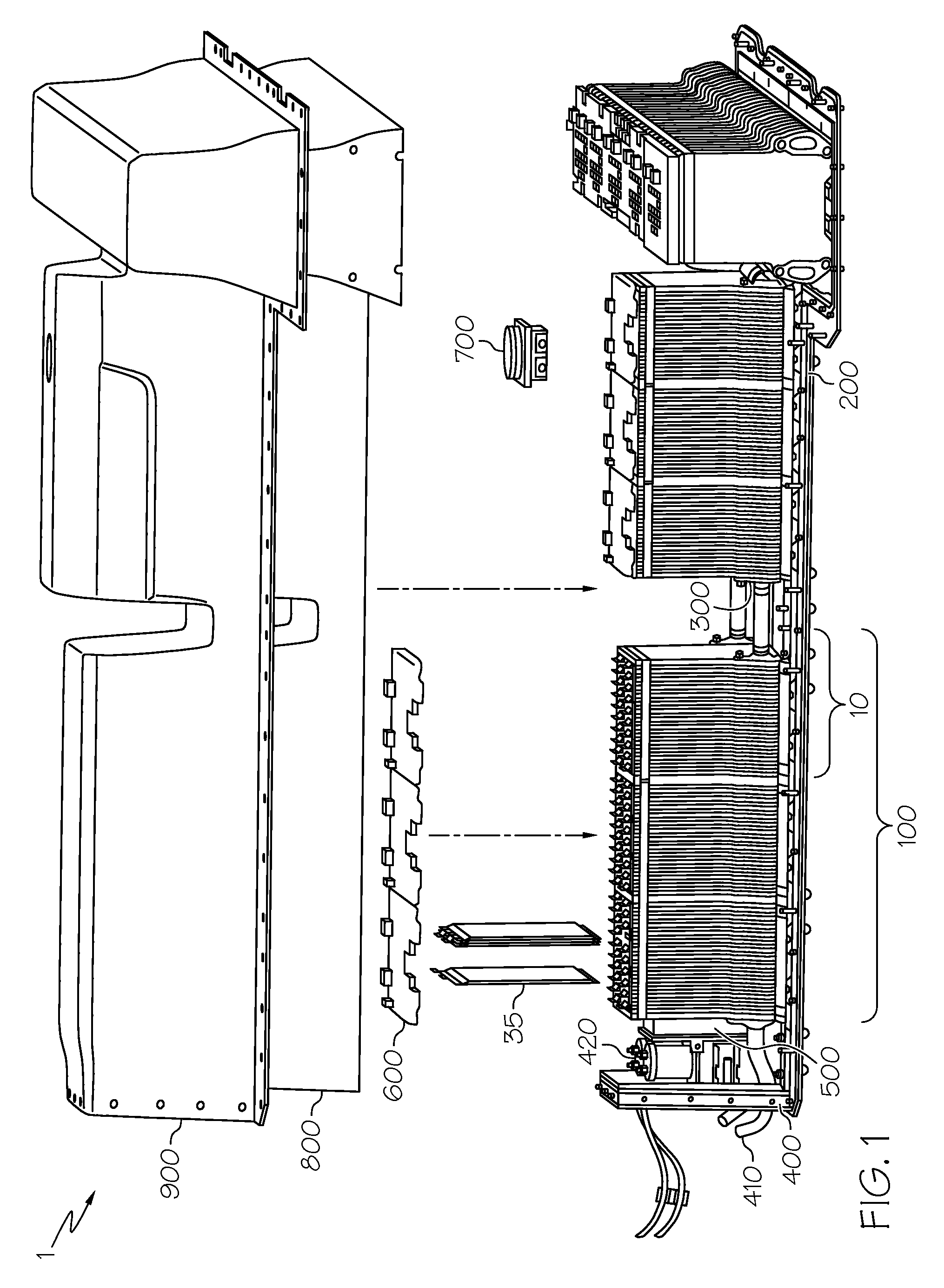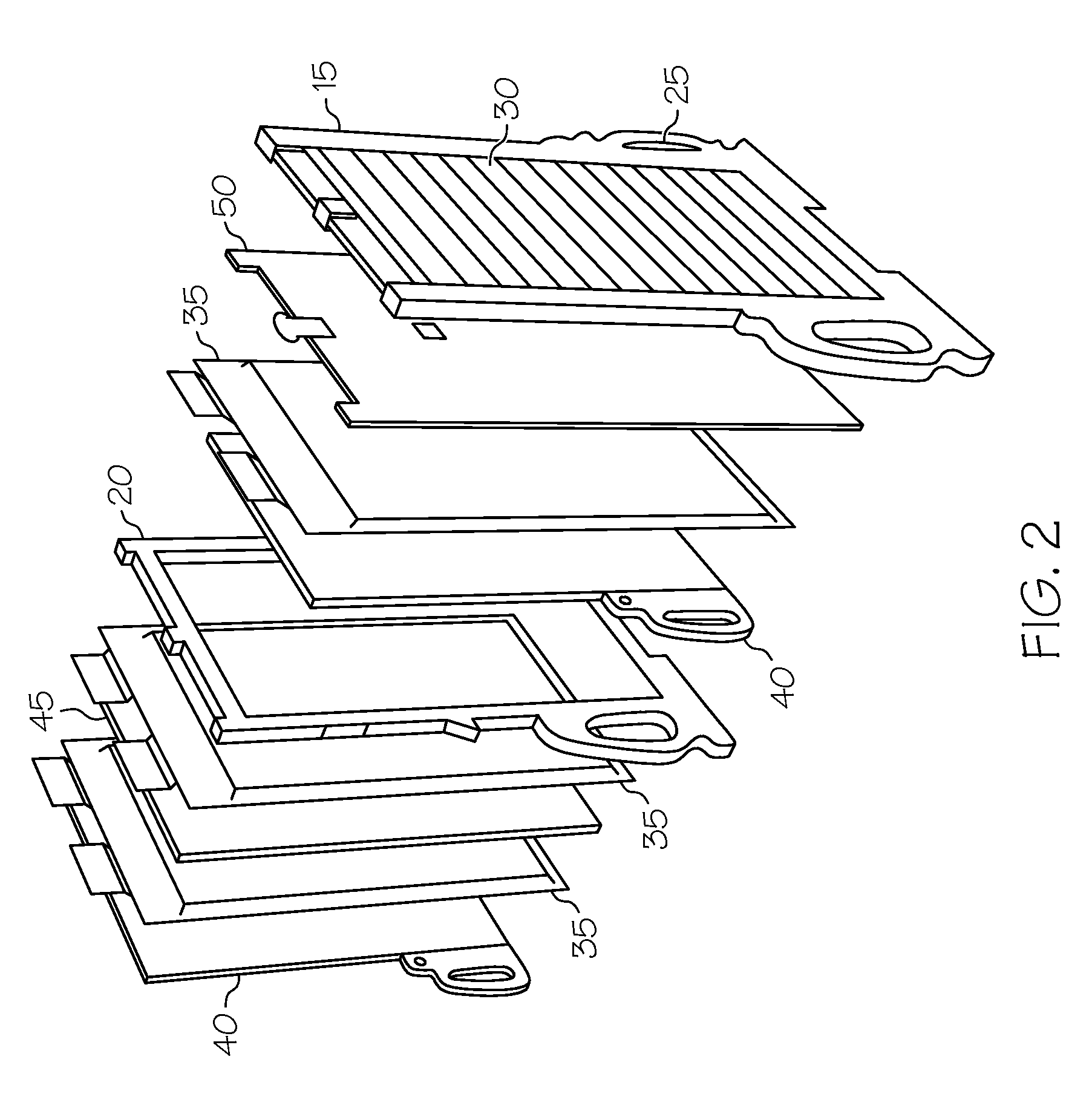[0005]A battery thermal management system based on a phase change material (PCM) has the potential to limit battery temperature extremes, thus acting to increase temperature uniformity, as well as to reduce heating and cooling requirements. This helps to prolong the life of heat-sensitive components, such as the charge-carrying battery cells that form the building blocks of battery modules and battery packs. PCMs can absorb and release a large amount of latent heat (in some instances up to fifty times higher than sensible heat) during isothermal (i.e., constant temperature) changes of phase, such as from solid-to-liquid or liquid-to-solid. As such, the use of PCMs can help to reduce or eliminate the need for active cooling components such as a fan, blower or pump in forced-air or forced-liquid cooling systems. This is beneficial in that the PCM can provide the ability to maintain the cell temperature in a desired temperature range without drawing power from the battery or another energy source. An example of a PCM-based approach to battery thermal management may be found in a co-pending U.S. patent application Ser. No. 13 / 175,483 entitled BATTERIES WITH PHASE CHANGE MATERIALS which was filed on the same day as the present application, owned by the Assignee of the present invention and hereby incorporated in its entirety by reference.
[0006]According to one aspect of the invention, a battery pack employing one or more battery modules which in turn employ one or more battery cells is disclosed. More particularly, a microencapsulated version of a PCM-based thermal management system is used to provide at least one of augmented heating or cooling to a configuration of such battery components. This version, known as a microPCM, is made up of very small bi-component particles or capsules that include a core material that exhibits latent heat changes tailored to a temperature range typically countered in an automobile battery pack, along with an outer shell or capsule made from a polymer or related material such that together, the core and shell define a generally spherical foam-like material. MicroPCM capsules range from less than one micron to several hundred microns in diameter, where all three states of matter (solids, liquids and gases) may be used to form the microencapsulatable core. Advantages compared to non-microencapsulated PCM includes increased protection of the core material, ease of incorporation into other materials, and decreased likelihood of leakage during melting. MicroPCMs may also be mixed in different mass percentages as a way to tailor their thermal response, for example, adjusting the phase change latent heat and phase change temperature. They can also be made to have more than one material be formed in the core such that each microPCM exhibits a thermal composite structure. Additional advantages include low material costs, where microencapsulation can include between about 50 and 90 percent active material.
[0011]The thermal management system of the present invention that employs microPCM is desirably applied to a battery to reduce repeated exposure to high temperatures that could otherwise lead to premature battery aging. More particularly, microPCMs in close contact with battery cells can act as a thermal buffer that in turn may result in reduced power fade, reduced capacity fade, improved battery life and durability, reduced warranty costs, improved vehicle range and prevention of thermal runaway. Furthermore, microPCMs with different (i.e., lower) melting points can be mixed in with the high-temperature microPCM, thereby providing protection against both high and low temperatures. For example, both a low-temperature phase change material and a high-temperature phase change material may be placed within a common capsule to result in one form of a composite microPCM. Likewise, a composite microPCM may include both low-temperature core-and-shell combinations mixed in with high-temperature core-and-shell combinations. In one form, the microPCM can be formed as part of a lithium-ion or related battery cell, or be part of a structural member or related component (such as foam isolator sheet, cooling plate or cooling fin) that can be placed in thermal communication with the battery cell.
[0012]Preferably, the bulk volume of the microPCM is in the wet-cake form (i.e., a mixture of solids and water). In the present context, the wet-cake form refers to the bulk volume of the whole bi-component particles; in one preferred form, it contains about 70% solids and about 30% water. Compared to its dry-cake form, microPCM in the wet-cake form reacts fast when blended with other materials and proves to be more stable by being less susceptible to separation. The microPCM can be uniformly coated on or melt-blended with polyurethane material to form a new thermal foam isolator sheet, or formed into channels that are part of a cooling plate or cooling fin. In one advantageous form, the microencapsulation of the PCM is such that it has a high degree of temperature stability, where leakage is kept to a minimum. The high heat capacity of the microPCM, coupled with the juxtaposition of the sheet, plate or fin to which it is attached, forms the basis of a passive thermal management system that acts independently of, or as part of active or other forms of cooling as part of an integrated cooling system. Thus, even in situations where active cooling may be warranted, the use of microPCM as part of an integrated cooling scheme offers the possibility of a simplified cooling system. Moreover, the microPCM of the present invention can be used whether the cooling medium is air-based or liquid-based.
[0014]Optionally, the microPCM is made up of an outer shell with an inner core of material of high latent heat absorption encased within the shell. In one form, the microPCM may include a low-temperature phase change material and a high-temperature phase change material such that the low-temperature phase change material is configured to experience a phase change from liquid to solid at a relatively low temperature, and further such that the high-temperature phase change material is configured to experience a phase change from solid to liquid at a relatively high temperature. Such relative temperatures preferably coincide with low and high temperatures that the automobile in general and the battery pack in particular may be exposed to. As discussed above, in one form, both the low-temperature and high-temperature core materials may be mixed together within a single shell, while in another, each may be retained autonomously within their own respective shells. This latter configuration permits the judicious placement of tailored-temperature microPCMs based on the expected local thermal environment.
 Login to View More
Login to View More 


